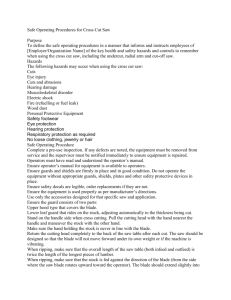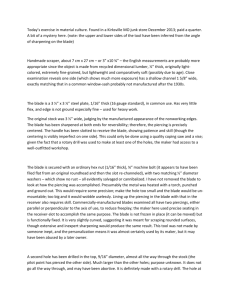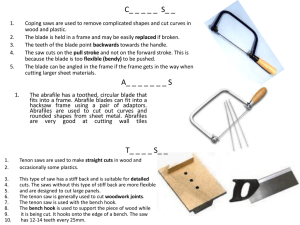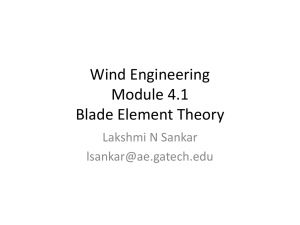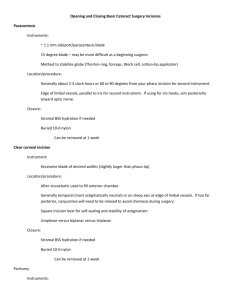Helicopter Lab 2
advertisement
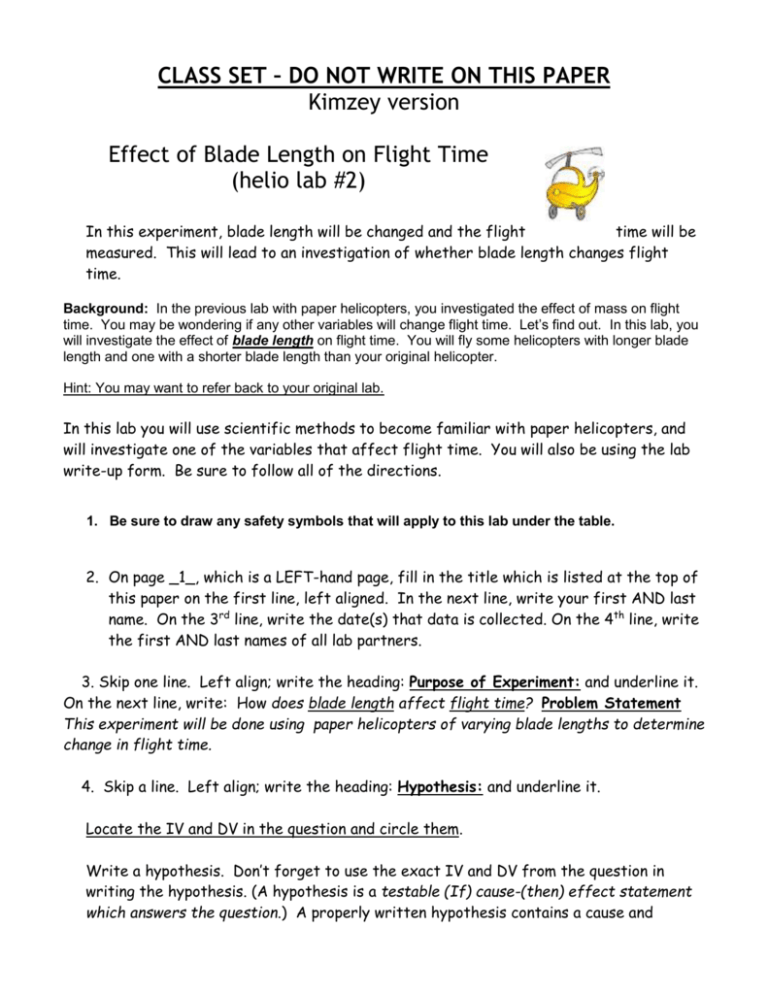
CLASS SET – DO NOT WRITE ON THIS PAPER Kimzey version Effect of Blade Length on Flight Time (helio lab #2) In this experiment, blade length will be changed and the flight time will be measured. This will lead to an investigation of whether blade length changes flight time. Background: In the previous lab with paper helicopters, you investigated the effect of mass on flight time. You may be wondering if any other variables will change flight time. Let’s find out. In this lab, you will investigate the effect of blade length on flight time. You will fly some helicopters with longer blade length and one with a shorter blade length than your original helicopter. Hint: You may want to refer back to your original lab. In this lab you will use scientific methods to become familiar with paper helicopters, and will investigate one of the variables that affect flight time. You will also be using the lab write-up form. Be sure to follow all of the directions. 1. Be sure to draw any safety symbols that will apply to this lab under the table. 2. On page _1_, which is a LEFT-hand page, fill in the title which is listed at the top of this paper on the first line, left aligned. In the next line, write your first AND last name. On the 3rd line, write the date(s) that data is collected. On the 4th line, write the first AND last names of all lab partners. 3. Skip one line. Left align; write the heading: Purpose of Experiment: and underline it. On the next line, write: How does blade length affect flight time? Problem Statement This experiment will be done using paper helicopters of varying blade lengths to determine change in flight time. 4. Skip a line. Left align; write the heading: Hypothesis: and underline it. Locate the IV and DV in the question and circle them. Write a hypothesis. Don’t forget to use the exact IV and DV from the question in writing the hypothesis. (A hypothesis is a testable (If) cause-(then) effect statement which answers the question.) A properly written hypothesis contains a cause and effect. The (If) cause is the independent variable (IV) and the (then) effect is the dependent variable (DV). 5. Create the IV, DV, Constants table. Fill it in for this lab. Remember, the independent variable for this lab is blade length. You will fly several different helicopters for this lab (each with a different blade length). Use the original helicopter from Lab #1 and three new helicopters. Two will have shorter blade lengths and one will have a longer blade length. The dependent variable is what you are measuring – flight time in seconds In order for this to be a fair, unbiased, test (controlled experiment), keep constant any other variables that could affect the flight time. This way, any changes observed come from changing blade length and nothing else. These factors are called constants (or “controlled variables”) because their value will stay the same for all tests. In order to have a fair test it is important to keep other variables constant. If not, they could affect the flight time. Make a list of several constants in the lab write up. Choose three - five constants as a sample from your list. Write these in the constants section of the chart. The constants can NOT be the IV or the DV. Independent Variable (IV) Dependent Variable (DV) XXXXXXXXXXXXXXXXXXX XXXXXXXXXXXXXXXXXXX XXXXXXXXXXXXXXXXXXX XXXXXXXXXXXXXXXXXXX XXXXXXXXXXXXXXXXXXX XXXXXXXXXXXXXXXXXXX XXXXXXXXXXXXXXXXXXX XXXXXXXXXXXXXXXXXXX Constants (CV) 6. Skip a line. Left align; write the heading: Equipment: and underline it. List all of the equipment and materials used to complete the experiment in columns. Include quantity (how many of each item) and amounts (grams, meters, g/m, blade lengths, etc. ) 1 helicopter ______ mm 1 helicopter ______ mm 1 helicopter ______ mm 1 helicopter ______ mm 2 meter sticks 1 timer _____ g _____ g _____ g _____ g 7. On page_2_ which is a RIGHT- hand page left align; write the heading: Procedures: and underline it. Procedures allow another scientist to repeat the experiment exactly. The procedures need to include the steps (in numerical order) necessary to collect the data, begin with a verb, be written and numbered sequentially, and contain NO pronouns except “it”. 1. 2. 3. 4. 5. 6. 7. Drop __mm helicopter from 200cm and start timer Stop timer when helicopter hits the ground Repeat step #1 – 2 four more times Repeat steps #1-3 with a __ mm helicopter Repeat steps #1-3 with a __ mm helicopter Repeat steps #1-3 with a __ mm helicopter Clean up *NOTE: in further investigations, it is critical that the ratio of increased blade length / mass remain the same to ensure that increased mass did not affect the outcome of this experiment. (!!!!! – this note must go under the procedures since this experiment has an error built into it by design. In an 8th grade classroom, it’s the best we can do, but another scientist with more sophisticated equipment may be able to control this uncontrolled variable. ) Create a paper helicopter using the template provided. Use scissors to cut on the solid lines, and then fold on the dotted lines. Here’s how to do it: 8. The ORIGNAL blade length from Lab #1 will be the Control Group (CG). The other blade lengths will be the Study Groups (SG) or Experimental Groups (EG). Write group member names on the helicopters and set them aside for now. 9. On page _3_, a LEFT-hand page, record data AS IT IS COLLECTED. Each person MUST record EACH trial AS IT OCCURS – EVERY TIME – NO EXCEPTIONS!! 10. It’s almost time to fly. Remember to have a fair test, be make sure to keep ALL of the CV’s constant. Go back and look at them now. Complete five trials for each of the blade lengths listed. Once flights are completed, calculate the means. Now… GO FLY!!!! 11.. Glue data table on top of the page. Trials Flight in sec. with __ mm blade Effect of Blade Length on Flight Time Flight in sec. Flight in sec. Flight in sec. with __ mm with __ mm with __ mm blade blade blade 1 2 3 4 5 MEAN Put the data for the CG in the first column and the data for the shortest blade in the last column. Column 2 will have the longest blade and column 3 will have the remaining blade. Notice that the headings for the data columns are the IV with its unit of measure – blade length. The numbers in the data columns are the control and experimental group values. On the stopwatch, a time which looks like 3 45 is recorded as 3.45 sec. For the last row, calculate the mean of the five flight times. 12. The data table should now be completely finished. Construct a line graph on page _4_, a RIGHT -hand page, using the blade length (IV) and flight time (DV) numbers from the data table. The IV will always go on the X axis along with trials and the DV will always go on the Y axis. Be sure to choose appropriate intervals for the data. Use the same title as the lab and the data table for the graph. 13.. On page _5_, a LEFT hand page, left align and write the heading: Error Analysis: and underline. For EACH error (data point that does NOT fall on the “line of best fit” you must indicate what error occurred. The format for this is: In trial ____ with a blade length of _____ mm, ______________________ __________ occurred, causing data to be (overstated / understated). Repeat this sentence for each and every data point off the line of best fit. 14. Skip a line and left-aligned, write the heading: Summary of Results: and underline it. For the Summary of Results, copy these sentences, fill in the blanks with information from the data table and graph. Be sure that you compare your CG to the greatest change for the “as compared to” sentence. THEN, go systematically through the rest of the data, sequentially – shortest to longest. The hypothesis was supported by the outcome of the experiment, therefore the experiment is valid. OR The hypothesis was not supported by the outcome of the experiment although the question was addressed, therefore the experiment is valid. When blade length decreases , flight time (increased / decreased). With __ mm blade length, the mean flight time was ____ sec. as compared to ___ mm blade length, the flight time was ___ sec. A greater blade length of ___ mm had a mean flight time of ____ sec. A blade length of ____ mm had _____sec. As blade length decreased, the mean flight time ____________ (increased, decreased, stayed the same). This is because _______________________________________ The data (does / does not) show a pattern, therefore it (is / is not) reliable.


